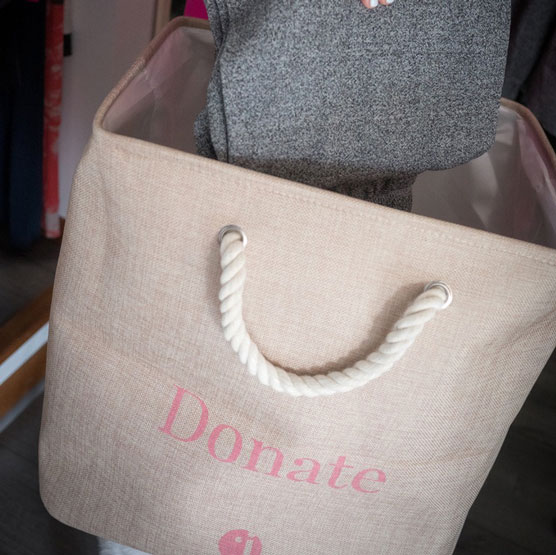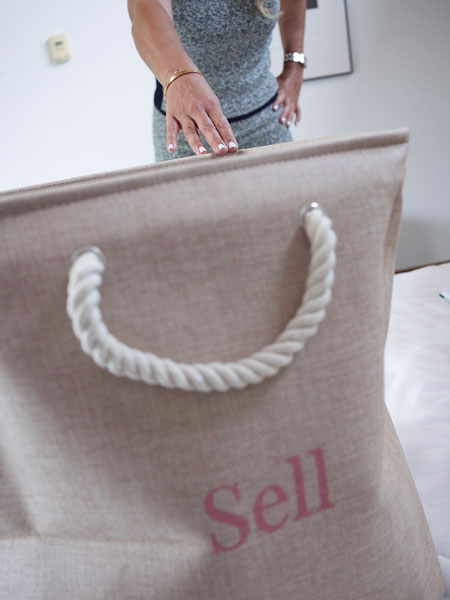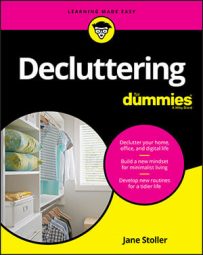I focus mostly on North American locations for donation sites and global locations for consignment options.
Donate your items
The act of giving not only helps others, but it also helps you feel good. Getting rid of items you no longer use frees them up for someone else who likely can use them. Giving brings others joy and is a great alternative to letting your items collect dust.The act of giving can also be a chance for you to connect with your community and really become more aware of how you can contribute to making the world a better place.
Today I see donation bins and cans all over the place. From various Walmart parking lots to strip-mall entrances to schools, donation bins are becoming popular and convenient.
One problem that can occur after decluttering is that your stuff sits in your house waiting to be dropped off at the local charity or donation spot. Often, the worst thing possible happens: That stuff designated to give someone else joy stays in your garage for ages, or worse, makes it back into your house. This is terrible because someone else really may have needed your items, and now all the efforts you and your family went through to declutter are wasted.
A great option is to pre-arrange a pick-up from a local charity. This forces you to have a deadline and ensures that your items actually get donated.
Following are five places in North America that have a pick-up service, but I recommend checking with your local charity, as availability of this service differs by city.
- Salvation Army: Most cities and small towns have a Salvation Army, so this is always your best bet to try first. This place has been around for over 150 years, so it is safe to say that they know what they’re doing and are skilled at giving your items to others who likely need them more. They accept pretty much anything as long as it is in good condition, such as clothes, kitchen accessories, books, and appliances. If you live in the U.S., you can go to their website and enter your zip code to schedule a pickup. It’s really that easy!
In Canada, depending on your location, residential pick-up may be available.
- Goodwill: Most cities also have a Goodwill. Contact them directly to see if they do pick-ups in your area.
- AMVETS: These are thrift stores that offer used clothing, household goods, and toys, and the revenue helps veterans’ programs.
- Habitat for Humanity: This one is big in Canada, and you can even volunteer your time to help build houses for this organization, which I have done to help impact my community. What is great is that they offer furniture pickup, and they can even restore it for re-use. Often furniture is not decluttered because you can’t physically move it out of the house easily, so this is a great option for furniture.
- Donation Town: This service connects you with a local charity where they come and pick up your items.
To keep donating top of mind, keep a box labeled “Donate” in your house. You can buy one from my website. These boxes are prettier and easier to carry than cardboard boxes. See the following figure.
 Image courtesy of Jane Stoller
Image courtesy of Jane StollerA “Donate” basket.
Sell your items
I resell lots of stuff and am almost always selling something. I have done this since eBay was invented in 1995. I was fascinated that there was a platform to sell and buy items in an auction environment. Now, I use a variety of online platforms to sell my items, from free apps to apps that charge a percentage per sale.I always recommend selling items that are like new and donating items that have more wear. I still bring my items to a store to resell, and on occasion I have still placed something on a street curb, although this is a method I discourage as many streets don’t allow it.
Selling direct to consumers
Some platforms allow you to sell an item to someone directly. You can use a third-party platform such as eBay to do this and pay a small user fee. Today there are so many sites to sell items that I can’t possibility list them all. There are free sites, such as Craigslist and Kijji, as well as sites that take a small fee for each item that is sold, such as Depop.There is no excuse for not being able to sell your items if they are in good condition, and it’s surprising what people will buy. I once even sold used soap dispensers because it was a reputable brand.
It takes only a couple of minutes to make an ad with your smartphone, and you can also ship items. As long as you have Wi-Fi, you can sell your items, no matter where you live.
Consigning clothes and other items
I consign my designer items and more expensive clothing. Some people ask why I do this instead of selling directly to the consumer. There are many reasons. For me, selling designer items can be tricky for both the buyer and the seller because there are many fakes or look-alikes that are causing problems in the luxury market. I buy lots of pre-loved clothing and accessories, but to be safe, I only buy them from reputable places that offer a designer inspection to make sure they are not fake. That is why you pay more to buy from one of these stores. If you are selling an item at a consignment store, there is a split between what the store takes and what you make. This split can be as high as 50 percent.Following are some pre-loved stores for buying and selling located in the U.S., the U.K., Canada, and Switzerland. All of them now offer online shopping and consigning:
- Fashionphile: Their motto is shop, sell, repeat. And if you buy an item you usually get the option to sell it back for a certain price within a few months. It’s like renting something, and it’s a genius idea.
- Vestiaire Collective: I am a major fan of this site because anything you buy comes with a stamp of quality and an authenticity check by someone on their team. This shop is based in the U.K. but ships and accepts items globally.
- LXR and Co: I have bought and sold several items from LXR and CO, and now they even sell directly in stores such as the Bay in Canada and Lord & Taylor in the U.S.
- Turnabout: My favorite physical consignment store in Vancouver, British Columbia, and now they also have online shopping options.
- LUX Luxury Shops: There is something very special about consignment stores in Europe. If you are ever in Zürich, Switzerland, this stop is a must. Also, in Paris there are many hidden gems. They really bring a new meaning to vintage and offer a European classic touch.
 Image courtesy of Jane Stoller
Image courtesy of Jane StollerA sell basket.
Most people forget that many of their friends or acquaintances within their networks would love their stuff. They may not love all of it, but there are surely a few items that friends may need or can use. Plus, friends are more likely to cherish your items and appreciate them than strangers you sell to.
Garage and yard sales are also a great option to sell your items to your community. If your local flea market is a hit, this may also be a great option.
Host exchange parties
Why not host a party where everyone can bring things to give to someone? If the guest list is shared ahead of time, you will have an idea of who is attending and what their style is.I call this a party because the more you can make donating and decluttering fun, the more likely you and your friends are to make it a habit.
One friend I know does not like these parties because she says she gets upset after she decides to part with clothes. She gets even more upset when she sees one of our friends wearing her items, and she usually wants them back. I always remind her that if she didn’t wear an item or didn’t feel comfortable in it, then it is wise to pass it along and be happy to be getting rid of clutter.
Bottom line, if you haven’t worn an item of clothing, or if it doesn’t make you feel great, donate it. I guarantee it will look great on someone else, but that doesn’t mean you should take it back. You gave it away for a reason, so stick to that. Plus, if it looks great on someone else and gives them confidence, that should be a great feeling for you, too.
Instead of a party, you could also do secret drops of items you know your friends will love at their houses. Facebook also has many selling groups that are becoming increasingly popular, especially among mothers.Repurpose and/or recycle items
I am a big fan of repurposing items, and I was encouraged to get creative with repurposing as a child. I grew up in a very rural community in a small town in Canada, and we didn’t have shopping malls that were close and there was no Amazon delivery back then. The only delivery option was the monthly Sears Catalog delivery, and even then, we had to drive to the hardware store 45 minutes away to pick it up. The struggles were real, but I had a lot less clutter!In hindsight this helped to make me more creative and resourceful, and for that I am thankful.
If you google “repurpose items,” you will literally be bombarded with hundreds of ideas of things you can make and creative uses for your old stuff.
I am not suggesting here that you keep stuff “just in case” you need to repurpose it, but if you can use it for something else, then do. I suggest repurposing what you can immediately rather than keeping it for years because you are going to get to it someday. Do it today, and if not, then it is best to make an alternative plan.
My favorite things to repurpose are items for my closet, and I have garnered so many ideas over the years. Here are my three favorites:- Ice cube trays: If your ice cube tray is leaking or you don’t need it anymore, it can be used to store small jewelry or pins that you always need for quick fixes.
- S-hooks or shower curtain rings: These are great for hanging belts, purses, hats, and umbrellas. Seriously, I love a good S-hook.
- Anything acrylic: If you can see through it, I love it already. Acrylic dividers and boxes are the best, and you can often use them for a multitude of things.
Here is a quick but not exhaustive list of recycling information to ensure you are taking every last step before something has to end up in the landfill:
- Plastics/bottles: From food items to storage bins
- Paper and cardboard: Includes snack and cereal boxes
- Paperwork: Phone books, magazines, mail, office paper, and newspaper
- Metals: Tins, aluminum, and steel cans
- Glass: Food storage and bottles
Last resort — the landfill
Now, I don’t like sending things to the dump. If at all possible, try to at least recycle. It’s amazing what can be recycled today.If, however, you need to get rid of an item that can’t be donated, sold, exchanged, repurposed, or even recycled, you have no other choice but to simply throw it away.
Be sure to reflect on what you are taking to the landfill or throwing in a dumpster. Could you have avoided buying that item in the first place?

